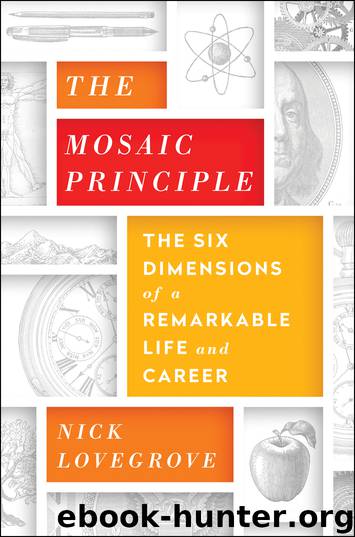The Mosaic Principle by Nick Lovegrove

Author:Nick Lovegrove
Language: eng
Format: epub
ISBN: 9781610395571
Publisher: PublicAffairs
Published: 2016-09-16T04:00:00+00:00
FIGURE 6.1. The Pando appears as separate trees, but are actually connected to a single organism. Reprinted with permission of Alamy Limited, Abingdon, Oxon, England.
CONTEXT MATTERS
Contextual intelligence is born of broad and diverse experience that enables you to understand and adapt to different contexts, and to operate effectively in all manner of situations and environments. It is rooted in the simple empirical observations that context differs and context matters—and that is why contextual intelligence is the fourth dimension of the Mosaic Principle.
In 1884, the social theorist Herbert Spencer suggested that the times produce the person and not the other way around. Through that lens, the more or less contemporaneous coexistence of the United States’ first generation of great leaders—Washington, Jefferson, Adams, Madison, Hamilton, Monroe, Franklin—could be seen not simply as a fortuitous demographic fluke that helped forge a nation but as a function of the extraordinary times in which they all lived. Indeed, historians have noted that several of the founders performed superbly in some roles but were relatively undistinguished in others.
The historian Jack Rakove declares that “the men who took commanding roles in the American Revolution were as unlikely a gang of revolutionaries as one can imagine. They became revolutionaries despite themselves.” For instance, John Adams, fearing British retaliation against the revolution, hesitated to give up his law career and only threw in his hat once elected as a delegate to the First Continental Congress. In turn, George Washington was happily focused on managing his agricultural and horse-breeding business until Adams nominated him as commander in chief of the Army. “I have used every endeavor in my power to avoid it,” he wrote. Stimulated by examples of adaptive leadership like this, Herbert Spencer argued that “what an individual actually does when acting as a leader is in large part dependent upon characteristics of the situation in which he functions.”
At the start of the twenty-first century, two Harvard Business School professors, Anthony Mayo and Nitin Nohria (who later became dean of the school), set out to fill a void in the field of management thinking: the lack of a canon of history’s greatest business leaders. Students of literature read the classics of Shakespeare, Milton, and Joyce; the Harvard professors believed that students of business should understand the history and critical biographies of Sloan, Procter, Disney, and the other business leaders from the past century who profoundly shaped American life. So Mayo and Nohria identified 1,000 great chief executives and company founders of the twentieth century; they then surveyed 7,000 of today’s business executives, asking them to evaluate and rank the original list of 1,000. Out of this they produced a ranking of the top 100 business leaders of the last century.
The resulting book, published in 2005 and entitled In Their Time: The Greatest Business Leaders of the 20th Century, seeks to isolate the most important lessons learned from the experience of these great men and women. Although their focus is on individual leaders, they argue that we should move beyond the “great man theory.
Download
This site does not store any files on its server. We only index and link to content provided by other sites. Please contact the content providers to delete copyright contents if any and email us, we'll remove relevant links or contents immediately.
The Compound Effect by Darren Hardy(8733)
Tools of Titans by Timothy Ferriss(8156)
Nudge - Improving Decisions about Health, Wealth, and Happiness by Thaler Sunstein(7459)
Win Bigly by Scott Adams(7032)
Deep Work by Cal Newport(6817)
Rich Dad Poor Dad by Robert T. Kiyosaki(6316)
Pioneering Portfolio Management by David F. Swensen(6168)
Principles: Life and Work by Ray Dalio(6130)
The Barefoot Investor by Scott Pape(5648)
Digital Minimalism by Cal Newport;(5586)
Grit by Angela Duckworth(5447)
The Slight Edge by Jeff Olson(5315)
Discipline Equals Freedom by Jocko Willink(5241)
The Motivation Myth by Jeff Haden(5123)
You Are a Badass at Making Money by Jen Sincero(4730)
The Four Tendencies by Gretchen Rubin(4514)
Eat That Frog! by Brian Tracy(4381)
The Confidence Code by Katty Kay(4158)
Bullshit Jobs by David Graeber(3991)
